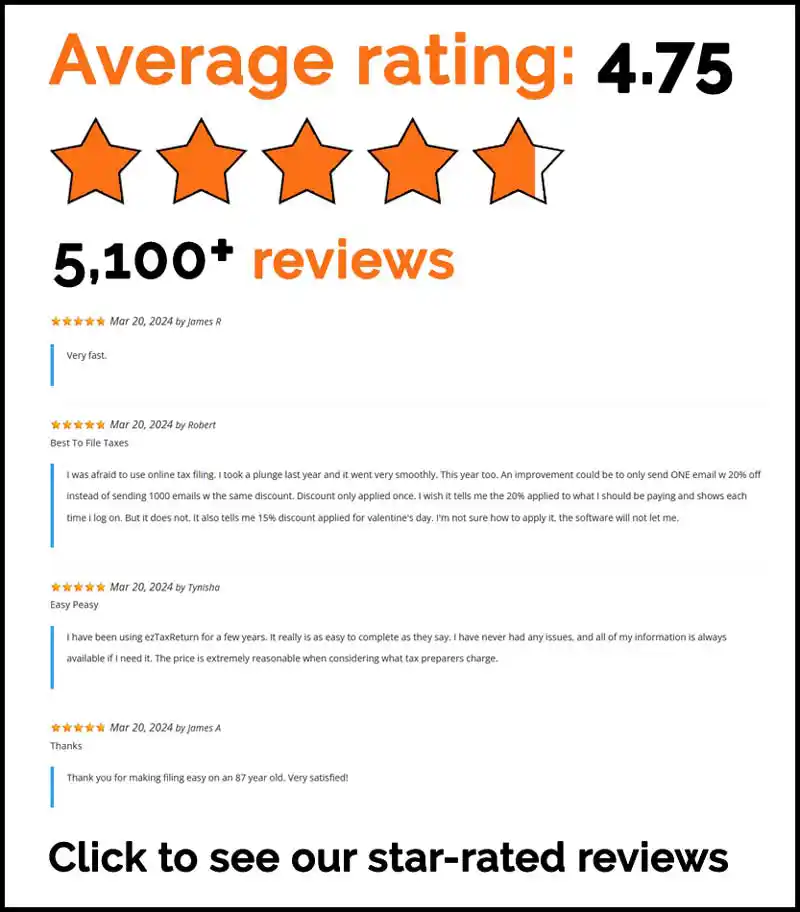The information in this article is up to date for tax year 2024 (returns filed in 2025).
It’s easy to overlook opportunities to save when you’re not familiar with the ins and outs of taxes. And the consequences are costly. Missing out on valuable tax breaks can result in you getting a smaller tax refund than you deserve, or even worse, owing the IRS. Sounds awful! To help you get your maximum refund, we’re pointing out some tax breaks filers commonly ignore, so you don’t miss out on savings.
What Is a Tax Break?
A tax break is any tax law that gives you the opportunity to reduce your tax bill. They usually come in the form of tax credits, tax deductions, tax exemptions, or exclusions of certain types of income. Tax credits can be incorporated into your annual tax filings with the IRS for the year in which qualifying upgrades are completed, reducing your federal income taxes. Certain credits can be applied against federal and state income taxes, detailing the eligibility requirements and specific forms that need to be filed to claim these credits on income tax returns. Tax breaks are typically created by the government to encourage specific social or economic behaviors.
Types of Tax Breaks: Deductions, Credits, and Exclusions
Navigating the world of taxes can be daunting, but understanding the different types of tax breaks can make a significant difference in your tax bill. Tax breaks generally fall into three categories: deductions, credits, and exclusions.
- Deductions: A tax deduction reduces your taxable income, which in turn lowers your overall tax liability. Common deductions include charitable donations, mortgage interest, and medical expenses. For instance, if you donate to a qualified charity, you can deduct the amount from your taxable income, reducing the amount of income tax you owe.
- Credits: A tax credit directly reduces your tax liability, dollar for dollar. This means that a $1,000 tax credit will reduce your tax bill by $1,000. Examples of tax credits include the earned income tax credit, child tax credit, and education credits. These credits can significantly lower the amount of federal income tax you owe, and some are even refundable, meaning you could receive a refund if the credit exceeds your tax liability.
- Exclusions: An exclusion allows you to exclude certain types of income from your taxable income. For example, Social Security benefits and foreign earned income can be excluded from your gross income, reducing the amount of income tax you owe.
Understanding these types of tax breaks can help you make informed decisions and maximize your tax savings.
The Child Tax Credit Can Save You up to $2,000 per Child
Welcomed a new bundle of joy into your family last year? Congratulations! You’re about to have even more to reason celebrate because you’re now eligible for the Child Tax Credit. It is can reduce your tax bill by up to $2,000 for each qualifying child under the age of 17. You may also be able to receive a partial refund of $1,700 through the Additional Child Tax Credit.
Save Up to $2,500 With the American Opportunity Tax Credit
Between tuition, books and fees, going to college costs an arm and a leg. Fortunately, your expenses can help you qualify for an education credit to lower your tax bill. If you’re an undergraduate student, you may be able to claim the American Opportunity Tax Credit which is worth up to $2,500 and is partially refundable. That means if you’ve paid all the necessary taxes and some of the credit is leftover, you can get up to 40% (or $1,000) as a refund. Doing your taxes can be fast, ez and stress-free. File with ezTaxReturn now and we’ll guide you every step of the way.
Workers Can Get the Earned Income Tax Credit (EITC)
The Earned Income Tax Credit (EITC) ranges from $632 to $7,830 depending on how much you make, the number of kids you claim and your adjust gross income. Generally, those with larger families get a higher credit amount. Smaller families or single individuals with no kids can claim the EITC, but don’t expect to receive the maximum credit. The income limits are as follows:
Single, head of household or widowed
- $59,899 with three or more qualifying children
- $55,768 with two qualifying children
- $49,084 with one qualifying child
- $18,591 with no qualifying children
Married filing jointly
- $66,819 with three or more qualifying children
- $62,688 with two qualifying children
- $56,004 with one qualifying child
- $25,511 with no qualifying children
Your investment income must also be less than $11,600 for the year.
Your Childcare Expenses Can Help You Get a Tax Break
Paying for childcare can take a big bite out of your budget. Fortunately, you may be able to claim the Child and Dependent Care Credit to recoup some of the costs when you do your taxes. How much can you claim for the Child and Dependent Care Credit? For tax year 2024, working parents can claim up to $3,000 in childcare expenses for one qualifying child and $6,000 for two or more qualifying children. The maximum credit is 35% of your expenses. To qualify, your dependent must be 12 or younger or a dependent or spouse of any age who is incapable of taking care of themselves. Your dependent must also live with you for at least half of the year.
Charitable Donations Are Tax-Deductible
Giving to those in need makes you feel good and can help you save money on your taxes. Whether you volunteer, give cash, or donate property to a qualified organization, your charitable contribution may be tax deductible. But you must itemize deductions to claim the deduction. Keep in mind that if you donate $250 or more, you must get a receipt from the organization. Itemizing allows taxpayers to reduce their taxable income through various available itemized deductions, such as medical expenses, charitable donations, and mortgage interest, each with specific rules and requirements. For more information on how to claim a deduction on charitable contributions, check out IRS Publication 526.
You Can Claim Gambling Losses
When it comes to gambling, you win some and you lose some. The IRS doesn’t care whether your prize money comes from a lottery ticket, horse race or the casino, they expect you to report your winnings on your tax return. But what you probably don’t realize is that if you itemize, you can deduct your gambling losses. The only drawback is that it cannot exceed the amount of your winnings. So, if you won $500, but lost $800, you can only deduct $500 of your losses.
Up to $300 of Educator Expenses Are Tax-Deductible
It’s not uncommon for teachers to dig into their own pockets to ensure their students have everything they need. And your generosity will pay off at tax time. Educators are allowed to deduct up to $300 of unreimbursed expenses. Qualified expenses include professional development courses, books, supplies computer equipment, and items that prevent the spread of Covid-19. Make sure to save your receipts if you plan to take the Educator Expense Deduction.
Get a Tax Break for Saving for Retirement
Taxpayers who contribute to a retirement plan, deferred compensation plan or an IRA, may be able to claim the Saver’s Credit on their federal tax return. To qualify you must be:
- At least 18 years old
- Not a full-time student, and
- Not listed as a dependent on someone else’s tax return.
Your adjusted gross income also cannot be more than:
- $76,500 if you’re married filing jointly,
- $57,375 if you’re head of household, or
- $38,250 if you’re single, married filing separately, or a qualifying surviving spouse.
The maximum credit is $1,000 ($2,000 for married couples filing jointly) for eligible filers.
Health Savings Accounts (HSAs) Offer a Triple-Tax Advantage
If you have a high-deductible health plan, opening a health savings account (HSA) can help you cover medical expenses more easily and lower your tax bill. An HSA lets you save pre-tax dollars to pay for medical expenses not covered by your insurance. The money you save lowers your taxable income, so you pay less taxes. Your money grows tax-free, and your withdrawals are tax-free when used for eligible medical expenses. The 2024 HSA contribution limit is $4,150 for individual coverage and $8,300 for family coverage. Once you turn 55, you have the option of contributing an additional $1,000. The deadline to make contributions for 2024 is April 15, 2025.
With ezTaxReturn, you can file with confidence knowing that you’re getting the biggest possible refund, guaranteed.
Energy Efficient Home Improvement Tax Credit
Thinking about making your home more energy-efficient? The Energy Efficient Home Improvement Tax Credit is a fantastic way to save money while reducing your carbon footprint. This refundable tax credit allows homeowners to claim up to $3,200 for energy-efficient upgrades to their primary residence.
To qualify, the improvements must be made to your home’s envelope, such as installing energy-efficient windows, doors, or insulation. These upgrades not only make your home more comfortable but also help you save on energy bills.
To claim this credit, you’ll need to file Form 5695 with your federal income tax return. Make sure to keep all receipts and documentation of the improvements to ensure you meet the eligibility requirements. By taking advantage of this tax credit, you can lower your tax bill and contribute to a greener planet.
Homeowner Tax Breaks
Owning a home comes with several tax benefits that can help reduce your tax liability. Here are some of the most common homeowner tax breaks:
- Mortgage Interest Deduction: If you have a mortgage, you can deduct the interest paid on your loan from your taxable income. This deduction can be substantial, especially in the early years of your mortgage when interest payments are higher.
- Property Taxes: Homeowners can also deduct the property taxes they pay from their taxable income. This deduction can provide significant savings, especially in areas with high property tax rates.
- Home Office Deduction: If you use a portion of your home exclusively for business purposes, you may be able to deduct expenses related to that space. This includes a portion of your rent or mortgage, utilities, and maintenance costs.
- Energy-Efficient Home Improvements: As mentioned earlier, homeowners can claim a credit for energy-efficient home improvements, such as installing solar panels and energy-efficient windows. This credit can help offset the cost of these upgrades and reduce your tax bill.
By taking advantage of these homeowner tax breaks, you can lower your taxable income and keep more money in your pocket.
Self-Employment Expenses Deduction
Being self-employed comes with its own set of challenges, but it also offers several tax benefits. Self-employed individuals can deduct various business expenses from their taxable income, reducing their tax liability. Here are some common self-employment expenses that can be deducted:
- Business Use of a Car: If you use your car for business purposes, you can deduct the business use percentage of your car expenses, including gas, maintenance, and insurance. Keep detailed records of your business mileage to ensure you claim the correct amount.
- Home Office Expenses: If you have a dedicated home office, you can deduct expenses related to that space, such as a portion of your rent or mortgage, utilities, and office supplies. The space must be used exclusively for business purposes to qualify.
- Business Travel Expenses: Travel expenses related to your business, such as transportation, lodging, and meals, can be deducted. Make sure to keep all receipts and documentation of your business trips.
- Business Equipment and Supplies: The cost of business equipment and supplies, such as computers, software, and office supplies, can also be deducted. These expenses can add up quickly, so be sure to keep track of all your purchases.
By deducting these expenses, you can lower your taxable income and reduce your overall tax liability.
How to Claim Tax Deductions and Credits
Claiming tax deductions and credits can be a great way to reduce your tax liability, but it can also be a complex process. Here are some steps to help you navigate the process:
- Gather All Necessary Documents: Before you start your tax return, gather all necessary documents, including receipts, invoices, and bank statements. Having all your documentation in one place will make the process smoother.
- Determine Eligibility: Review the eligibility requirements for various tax deductions and credits to determine which ones you qualify for. This may include reviewing IRS guidelines or consulting with a tax professional.
- Complete the Necessary Forms: Fill out the necessary forms for the deductions and credits you are claiming. For individual tax returns, this typically includes Form 1040 and any relevant schedules.
- File the Tax Return: Submit your tax return by the deadline, which is typically April 15th for individual tax returns. Filing on time helps you avoid penalties and ensures you receive any refunds promptly.
- Claim the Deductions and Credits: On your tax return, claim the deductions and credits you are eligible for. Make sure to follow the instructions carefully and double-check your calculations to avoid errors.
Using ezTaxReturn to file your taxes can help ensure that you claim all the deductions and credits you are entitled to and avoid any potential issues with the IRS. By following these steps, you can maximize your tax savings and reduce your overall tax liability.
The articles and content published on this blog are provided for informational purposes only. The information presented is not intended to be, and should not be taken as, legal, financial, or professional advice. Readers are advised to seek appropriate professional guidance and conduct their own due diligence before making any decisions based on the information provided.




